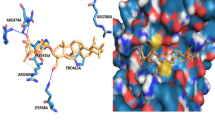Abstract
Purpose: Benzoquinone ansamycins are antibiotics with anticancer potential. First described as tyrosine kinase inhibitors, they are now frequently used to target HSP90 chaperone function. While herbimycin A and geldanamycin (GA) have been widely used in preclinical studies, both drugs are poor candidates for clinical trials owing to their in vivo toxicity and lack of stability. We therefore examined the biologic effects of 17-allylamino-17-demethoxygeldanamycin (17-AG), an ansamycin derivative with lower in vivo toxicity than GA. Methods: Binding of 17-AG to HSP90 was studied in vitro using a GA-affinity beads competition assay. We analyzed the drug-induced destabilization of p185erbB2, Raf-1 and mutant p53 in SKBR3 breast cancer cells by Western blotting. The antiproliferative activities of 17-AG and GA were compared using the MTT assay. Results: We found that, in a similar manner to GA itself, 17-AG bound specifically to HSP90. It also led to degradation of the receptor tyrosine kinase p185erbB2, the serine/threonine kinase Raf-1 and mutant p53. Both GA and 17-AG displayed comparable antiproliferative effects in SKBR3 and MCF7 cells. Even though HSP90 binding by 17-AG was weaker than by GA, 17-AG and GA caused biologic effects in tumor cells at similar doses. Conclusion: 17-AG shares the important biologic features of its parent compound GA. Since 17-AG has a better toxicity profile than GA, it is an interesting candidate benzoquinone ansamycin for clinical development.
Similar content being viewed by others
Author information
Authors and Affiliations
Additional information
Received: 4 August 1997 / Accepted: 16 December 1997
Rights and permissions
About this article
Cite this article
Schulte, T., Neckers, L. The benzoquinone ansamycin 17-allylamino-17-demethoxygeldanamycin binds to HSP90 and shares important biologic activities with geldanamycin. Cancer Chemother Pharmacol 42, 273–279 (1998). https://doi.org/10.1007/s002800050817
Issue Date:
DOI: https://doi.org/10.1007/s002800050817




